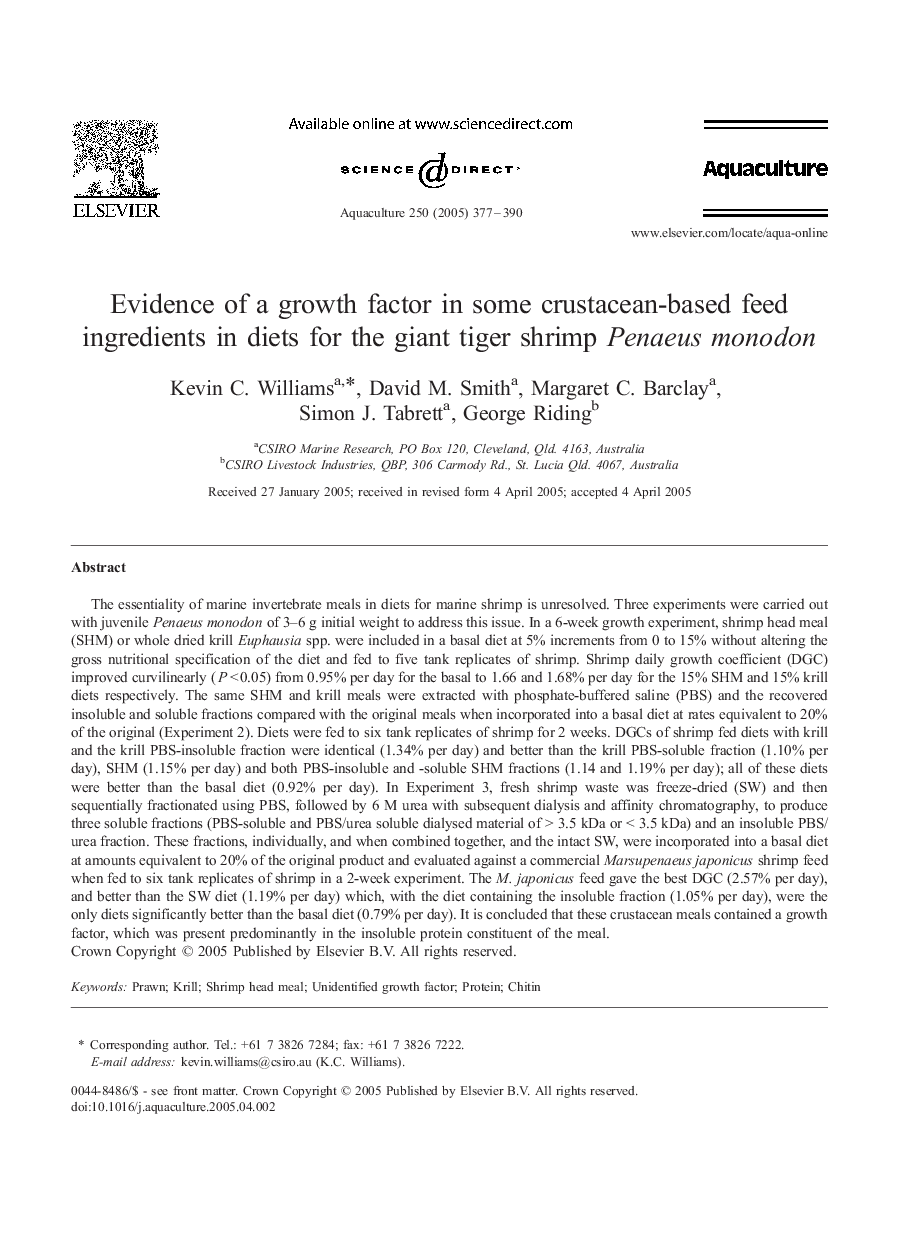| کد مقاله | کد نشریه | سال انتشار | مقاله انگلیسی | نسخه تمام متن |
|---|---|---|---|---|
| 8974619 | 1552992 | 2005 | 14 صفحه PDF | دانلود رایگان |
عنوان انگلیسی مقاله ISI
Evidence of a growth factor in some crustacean-based feed ingredients in diets for the giant tiger shrimp Penaeus monodon
دانلود مقاله + سفارش ترجمه
دانلود مقاله ISI انگلیسی
رایگان برای ایرانیان
موضوعات مرتبط
علوم زیستی و بیوفناوری
علوم کشاورزی و بیولوژیک
علوم آبزیان
پیش نمایش صفحه اول مقاله

چکیده انگلیسی
The essentiality of marine invertebrate meals in diets for marine shrimp is unresolved. Three experiments were carried out with juvenile Penaeus monodon of 3-6 g initial weight to address this issue. In a 6-week growth experiment, shrimp head meal (SHM) or whole dried krill Euphausia spp. were included in a basal diet at 5% increments from 0 to 15% without altering the gross nutritional specification of the diet and fed to five tank replicates of shrimp. Shrimp daily growth coefficient (DGC) improved curvilinearly (PÂ <Â 0.05) from 0.95% per day for the basal to 1.66 and 1.68% per day for the 15% SHM and 15% krill diets respectively. The same SHM and krill meals were extracted with phosphate-buffered saline (PBS) and the recovered insoluble and soluble fractions compared with the original meals when incorporated into a basal diet at rates equivalent to 20% of the original (Experiment 2). Diets were fed to six tank replicates of shrimp for 2 weeks. DGCs of shrimp fed diets with krill and the krill PBS-insoluble fraction were identical (1.34% per day) and better than the krill PBS-soluble fraction (1.10% per day), SHM (1.15% per day) and both PBS-insoluble and -soluble SHM fractions (1.14 and 1.19% per day); all of these diets were better than the basal diet (0.92% per day). In Experiment 3, fresh shrimp waste was freeze-dried (SW) and then sequentially fractionated using PBS, followed by 6 M urea with subsequent dialysis and affinity chromatography, to produce three soluble fractions (PBS-soluble and PBS/urea soluble dialysed material of >Â 3.5 kDa or <Â 3.5 kDa) and an insoluble PBS/urea fraction. These fractions, individually, and when combined together, and the intact SW, were incorporated into a basal diet at amounts equivalent to 20% of the original product and evaluated against a commercial Marsupenaeus japonicus shrimp feed when fed to six tank replicates of shrimp in a 2-week experiment. The M. japonicus feed gave the best DGC (2.57% per day), and better than the SW diet (1.19% per day) which, with the diet containing the insoluble fraction (1.05% per day), were the only diets significantly better than the basal diet (0.79% per day). It is concluded that these crustacean meals contained a growth factor, which was present predominantly in the insoluble protein constituent of the meal.
ناشر
Database: Elsevier - ScienceDirect (ساینس دایرکت)
Journal: Aquaculture - Volume 250, Issues 1â2, 14 November 2005, Pages 377-390
Journal: Aquaculture - Volume 250, Issues 1â2, 14 November 2005, Pages 377-390
نویسندگان
Kevin C. Williams, David M. Smith, Margaret C. Barclay, Simon J. Tabrett, George Riding,